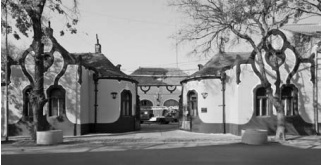Romantic ideas, from the turn of the nineteenth and twentieth centuries, reflected in the exterior decoration of facade ceramics, reflected the desire of Eden Lehner to create a national style in the construction industry.
One of Lehner’s students always pointed out to White Lite (1873-1920) because he was not an ordinary follower, but further enhanced the values of Lehner’s secession and became one of the leading figures of Hungarian modern architecture, using motifs from Hungarian folklore decorative arts, so that buildings meet the requirements of modern architecture.
Based on the periodization of Artur Bardoš, the creation of Bela Lajte in the first years of the twentieth century belongs to the “Lehnerner – period”. After 1905, Lajta is completely moving away from this direction.
The first years of the 20th century were marked by the booming architecture of “new ruins”, on new bases. These palaces seemed to “speak Hungarian”, and Lajta dreamed of this and remained loyal to the style of Hungarian builders for the longest time.
In the same period, in Budapest, the buildings were still unable to color “vibrant colors” and decorate with new forms and national motifs. In the province, however, secessionist buildings, both public and private houses, were one after the other. Citizens Sente at that time dreamed of raising a proper firefighting home in their city. They turned to the City Senate and were granted permission to build on March 2, 1902. Seneca’s lawyer, Dr Deže Hajdu, became the president of the renewed administration of the Firefighter Association on January 12, 1902.
The construction was entrusted to the new president, and he began negotiations with Macház Szabó, an architect from Senta. Soon when he went to Budapest for a home loan, the president met with a young, but already recognized architect, White Lightsdorfer (Lajt), and arranged for him to do a project for a fire brigade in Senta. The construction began in October, 1903, under the direction of Machas Sabo. The business took place at a high speed. The foundation stone was laid already on November 18, in front of many interested citizens. In the leaves that went out in Sent, it was said that the building would be so impressive and beautiful that it would adorn not only Sent but would look far beyond the appearance and functionality. Firefighters could move to their new home on June 29, 1904, when their buildings were handed over to use.White Lite participated in the ceremony, addressing the audience with a solemn speech.
The building still exists in its original form, and it was proclaimed a cultural monument on May 14, 1975.
The purpose-built building of the barracks, with three, functionally different pavilions, formally forming a unique whole, has very well fit into the urban structure of the city. The two buildings of the dilapidated basement, built on the regulating line of the street, connect the arched gate. Towards the street are located: office of the president, meeting room, entertainment room, libraries and reading room. In the depths of the yard, along with the gate, they are grouped together: a warehouse, a cabinets, a dormitory, an observation room and a dining room. On the very back, there was a warehouse for fire hoses, a caravan, a steam for eight pairs of horses and the necessary facilities.
The fire brigade in Senta is a proof of innovation in the functional organization and forms of White Lite. The original projects of the barracks have disappeared, and its original appearance has been determined on the basis of old photographs stored in the fire brigade. Minor changes were made on the facility to meet the modern needs of the fire department. The building still serves the original purpose today.
Two street tracts (two key parts of the building) are interestingly conceived, because in this respect, Lajta is most distant from his teacher. Namely, Lehner did not bring innovation into the ground plan and did not apply the constructive elements of national construction, while Lite was the goal from the very beginning.
If we analyze not only the basis, but the entirety of the building, we notice a sophisticated game of forms and ornaments. A careful observer will notice Lajt’s excellent architectural conception. He used traditional building materials: brick, mortar, wood and sheet metal. The glossy ceramics, so popular in that period, are not found on this facade. Probably the material circumstances of the city affected the fact that Lite for decoration applied only a shallow relief in plaster. The façade is a harmonious whole, only on the flat façade surface, ritual reparations of plaster are repeated. Every detail has its own meaning, like a folk ballad (as Lajt would say). In the construction of the façade, Lehner follows: the flat walls are crowned by Lehner’s idols, and the wavy edges of the facade and the attic are adorned with striped decoration. Below there are individual decorations in the shape of a heart,as well as ornaments in a series that follow the wavy line of the eagle. Above the sump, in the window shaft, there are two heart shaped tiles.
After 1904, White Lite no longer came to Vojvodina, but mostly worked in Budapest. He continued on the path he started in Senti: rationalism with emphasis on constructive elements.
Bela Lajte’s buildings in Senta stand out from other achievements of Lehner’s followers, precisely because of their simplicity, and they are a sign that the secession slowly moves on new roads.
FIREFIGHTERS’ BARRACKS


0 comments on “FIREFIGHTERS’ BARRACKS”